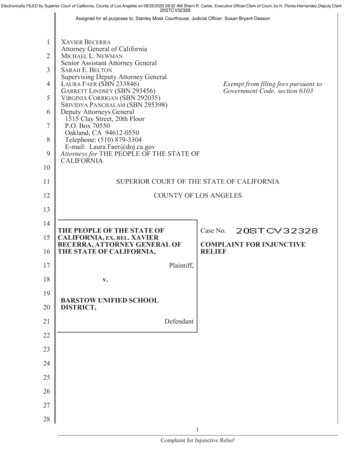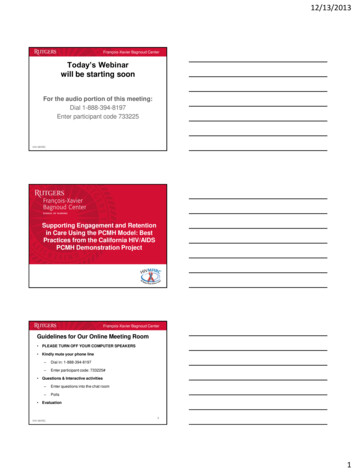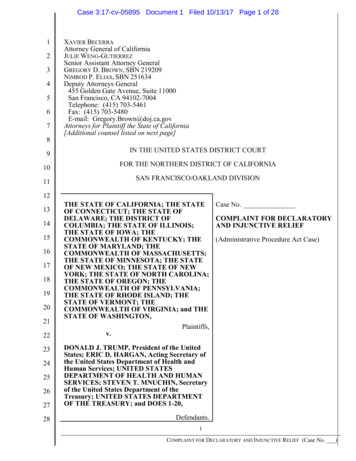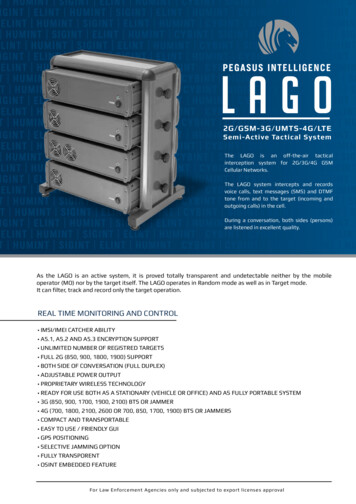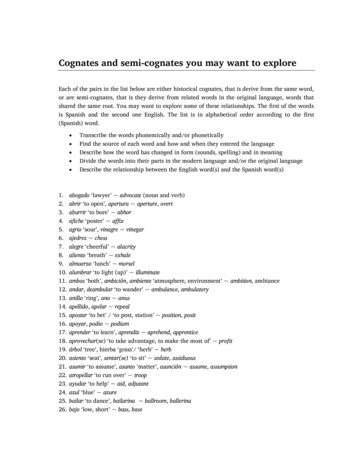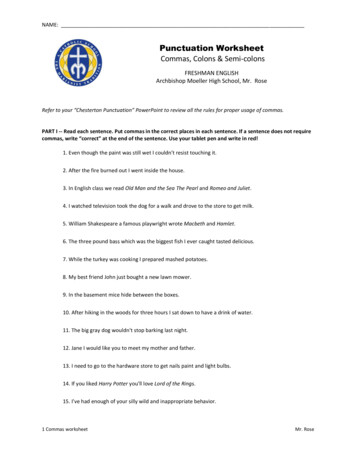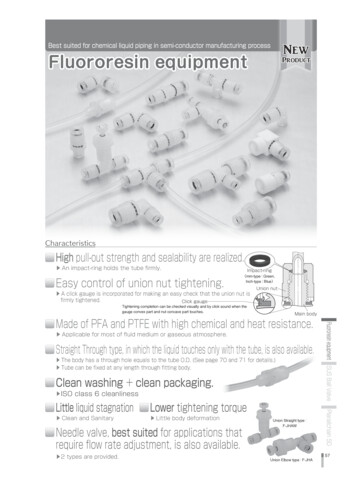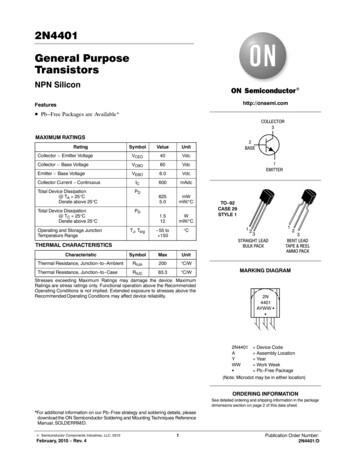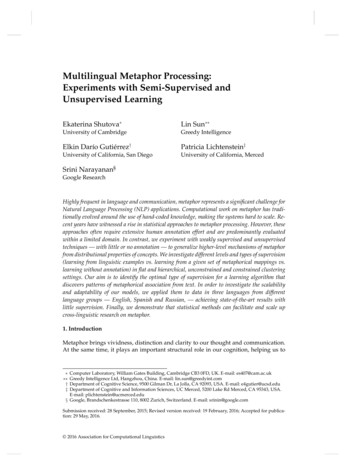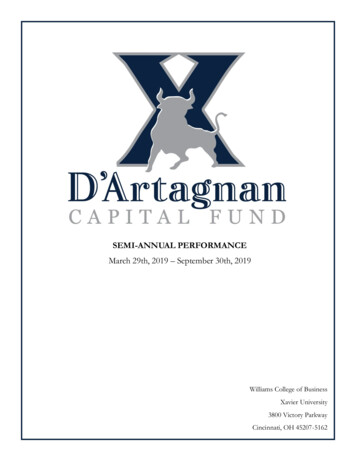
Transcription
SEMI-ANNUAL PERFORMANCEMarch 29th, 2019 – September 30th, 2019Williams College of BusinessXavier University3800 Victory ParkwayCincinnati, OH 45207-5162
Table of ContentsBoard of Executive Advisors . . . . . . . . . . . . . . . . . . . . . . . . . . . . . . . . . . . . . . . . . . . . . . . . . . . . . . . . 3A Letter from the CEO . . . . . . . . . . . . . . . . . . . . . . . . . . . . . . . . . . . . . . . . . . . . . . . . . . . . . . . . . . . . .4Strategy Statement . . . . . . . . . . . . . . . . . . . . . . . . . . . . . . . . . . . . . . . . . . . . . . . . . . . . . . . . . . . . . . . . . 5Fund Members . . . . . . . . . . . . . . . . . . . . . . . . . . . . . . . . . . . . . . . . . . . . . . . . . . . . . . . . . . . . . . . . . . . .6Market Summary . . . . . . . . . . . . . . . . . . . . . . . . . . . . . . . . . . . . . . . . . . . . . . . . . . . . . . . . . . . . . . . . . .10Performance Report . . . . . . . . . . . . . . . . . . . . . . . . . . . . . . . . . . . . . . . . . . . . . . . . . . . . . . . . . . . . . . .12Semi-Annual Performance . . . . . . . . . . . . . . . . . . . . . . . . . . . . . . . . . . . . . . . . . . . . . . . . . . . . 13DCF Returns vs. S&P500 Total Return Index . . . . . . . . . . . . . . . . . . . . . . . . . . . . . . . . . . . . .14Attribution Analysis . . . . . . . . . . . . . . . . . . . . . . . . . . . . . . . . . . . . . . . . . . . . . . . . . . . . . . . . . .16Top Contributors . . . . . . . . . . . . . . . . . . . . . . . . . . . . . . . . . . . . . . . . . . . . . . . . . . . . . . . . . . . 18Bottom Contributors . . . . . . . . . . . . . . . . . . . . . . . . . . . . . . . . . . . . . . . . . . . . . . . . . . . . . . . . .19Performance Comparison . . . . . . . . . . . . . . . . . . . . . . . . . . . . . . . . . . . . . . . . . . . . . . . . . . . . .20Risk Analytics . . . . . . . . . . . . . . . . . . . . . . . . . . . . . . . . . . . . . . . . . . . . . . . . . . . . . . . . . . . . . . .21Semi-Annual Trade Report . . . . . . . . . . . . . . . . . . . . . . . . . . . . . . . . . . . . . . . . . . . . . . . . . . . . . . . . . 22Economic Report . . . . . . . . . . . . . . . . . . . . . . . . . . . . . . . . . . . . . . . . . . . . . . . . . . . . . . . . . . . . . . . . .24Sector Reports . . . . . . . . . . . . . . . . . . . . . . . . . . . . . . . . . . . . . . . . . . . . . . . . . . . . . . . . . . . . . . . . . . . .27Communications Services . . . . . . . . . . . . . . . . . . . . . . . . . . . . . . . . . . . . . . . . . . . . . . . . . . . . .27Consumer Discretionary . . . . . . . . . . . . . . . . . . . . . . . . . . . . . . . . . . . . . . . . . . . . . . . . . . . . . .35Consumer Staples . . . . . . . . . . . . . . . . . . . . . . . . . . . . . . . . . . . . . . . . . . . . . . . . . . . . . . . . . . .44Energy . . . . . . . . . . . . . . . . . . . . . . . . . . . . . . . . . . . . . . . . . . . . . . . . . . . . . . . . . . . . . . . . . . . .52Financials . . . . . . . . . . . . . . . . . . . . . . . . . . . . . . . . . . . . . . . . . . . . . . . . . . . . . . . . . . . . . . . . . . 60Healthcare . . . . . . . . . . . . . . . . . . . . . . . . . . . . . . . . . . . . . . . . . . . . . . . . . . . . . . . . . . . . . . . . . 68Industrials . . . . . . . . . . . . . . . . . . . . . . . . . . . . . . . . . . . . . . . . . . . . . . . . . . . . . . . . . . . . . . . . . .78Information Technology . . . . . . . . . . . . . . . . . . . . . . . . . . . . . . . . . . . . . . . . . . . . . . . . . . . . . .87Materials . . . . . . . . . . . . . . . . . . . . . . . . . . . . . . . . . . . . . . . . . . . . . . . . . . . . . . . . . . . . . . . . . . 97Real Estate . . . . . . . . . . . . . . . . . . . . . . . . . . . . . . . . . . . . . . . . . . . . . . . . . . . . . . . . . . . . . . . . 102Utilities . . . . . . . . . . . . . . . . . . . . . . . . . . . . . . . . . . . . . . . . . . . . . . . . . . . . . . . . . . . . . . . . . . .107Definitions . . . . . . . . . . . . . . . . . . . . . . . . . . . . . . . . . . . . . . . . . . . . . . . . . . . . . . . . . . . . . . . . . . . . . 113Disclosures . . . . . . . . . . . . . . . . . . . . . . . . . . . . . . . . . . . . . . . . . . . . . . . . . . . . . . . . . . . . . . . . . . . . . 114D’Artagnan Capital Fund2
Xavier University Finance Department Board of Executive AdvisorsMichael AndrioleEndocyte, Inc.CFOJ. Douglas GerstleProcter & GambleAssistant Treasurer,Global TreasuryThomas E. Lieser, Jr.Stifel Financial ServicesSenior VP, Wealth ManagementDenise BanksVerso CorporationCommercial AnalystBrian GilmartinTrinity Asset ManagementPortfolio ManagerAnne Marie LynchGE AviationVP and CFO, Aviation ServicesTony BealUSI Insurance ServicesSVP-P&C Market Relationship LeaderGeorge A HaddadMerrill Lynch-The Haddad GroupSenior VP, Wealth ManagementJonathan W. Reynolds, CFAFifth Third BankSenior VP, Chief Investment OfficeMegan BoscoWealth Dimensions GroupFinancial AdvisorTami Lee HendricksonFed. Home Loan Bank of CincinnatiSenior VP/TreasurerJuan RiveraAmerican Express Global BusinessChief Accounting OfficerMatthew M. CarlstedtCitimarkVP, InvestmentsRebecca HochstetlerProcter & GambleExternal Reporting ServicesMichael W. SchwanekampMFS Investment ManagementManaging DirectorThomas M. CooneyCooney, Faulkner & Stevens, LLCPresidentWilliam P. HoganAmerican Money ManagementSenior VP – InvestmentsKathryn L. WardThe Kroger CompanyDirector of Investor RelationsJonathon M. Detter, CFAWCM Investment ManagementPortfolio ManagerKevin R. KaneOptimized TransitionsInvestment Strategist/Relationship-ManagerKevin P. Whelan, CFAOpus Capital ManagementVP and Portfolio ManagerAida S. DragovicMacy’s Inc.VP, Financial PlanningWilliam EfflerAmerican Money Management(Retired)R. Bryan KroegerUS BankSVP-Middle Market LendingJames E. Wilhelm, Jr.Ft. Washington Investment Advisors,Inc.Senior Portfolio ManagerJames Alan LenahanFund Evaluation GroupManaging Principal/Director ofHedged StrategiesRebecca S. WoodFund Evaluation GroupManaging PrincipalJames EglsederFifth Third BankManaging Director-Corporate StrategyD’Artagnan Capital Fund3
A Letter from the CEOD’Artagnan Capital Fund Family and Friends,Thank you for taking the time to review our Semi-Annual performance for Fiscal Year 2019. The results within thesepages are supported by nearly 5,000 combined hours of equity research, more than 300 hours of community service, 187,000 in value creation, and 1 overall team objective to generate a meaningful return for our client, Xavier University.As a class we would like to thank you all for the trust and responsibility you have put in each of us to care for and polish thisprogram to be the best hands-on learning experience it can be.By the time this report gets to press, we will be closing out the decade of the 2010’s. Before I review any of ourcurrent facts and figures, I think it’s worthwhile to reflect on where our Fund began and the progress we’ve made since then.In October of 2008, barely a month after the near-collapse of the American financial system, Xavier teachingprofessor Stafford Johnson, Ph. D. approached the University administration and asked for a second investment fund to becreated for undergraduate finance majors. It would complement the existing Fixed Income Fund for MBA students, with thegoal of attempting to beat a benchmark, the S&P 500.The administration agreed and in February 2009 allocated 500,000 for the undergraduate finance students to investin large-cap, long equity positions. In November of 2009, the Fund received a second allocation of 500,000 and a newdirector, Dr. David Hyland. This was the formal creation of the D’Artagnan Capital Fund as we know it today.The process evolved over the years, with every class of students bringing new ideas and improvements along withthem. From the format of the Annual and Semi-Annual reports to the name of the Fund itself, the current success of theCapital Fund was laid by the dedicated students before us, all with the intent of making this experience as “real” andinteractive as it could be.With these humble beginnings in mind, I am pleased to report our Semi-Annual performance results as ofSeptember 30th, 2019. We closed our book on September 30 th with 3.31 million assets-under-management (AUM),recording a 6-month return of 5.99%. We as a Fund have been very lucky to participate in the longest economic expansion inU.S. history, and we couldn’t have maintained this level of focused performance without a robust process guided by Dr.Hyland’s expertise.The Fund is one of the most transformative experience The Williams College of Business has to offer, in thatportfolio management is only one of the many topics students learn about during their time here. Along they way, whetherthey realize it or not, students build research skills, decision making ability, and the confidence to defend their convictionsbefore an audience. It is truly a gift to have such a diverse learning opportunity, and one we don’t take for granted.This is only the half-way point in our fiscal year, and I have every confidence that the D’Artagnan Capital Fund is inextremely capable hands. It is a very exciting time to be in the markets, and it has been an adventure to compete in anindustry where no two days are ever the same. I look forward to seeing how this Fund continues to grow, and I thank eachand every one of you for your time, your constant support, and your confidence in our abilities.Alex OriansCEOD’Artagnan Capital Fund4
Strategy StatementThe D’Artagnan Capital Fund is an actively-managed opportunities fund that focuses on investments in the large-capand greater equity universe through a bottom-up valuation approach. Equities presented in the fund are researched extensively by sector analysts with the direction of portfolio managers whom are responsible for their respective sector. Through rigorous peer review of valuation models, research, and investment rationales, we seek to continuously outperform our benchmark, the S&P 500 Total Return index, on a risk adjusted basis while remaining within our compliance by selecting the mostundervalued equities in the universe that we can chose from.The D'Artagnan Capital Fund is solely run by Xavier University students. We manage approximately 3.3 million forXavier's Endowment as of September 30, 2019. Per our prospectus, our exposure is limited to large-cap equities, and we currently manage a portfolio of 47 holdings.Disclaimer: All information contained in this report is the opinion and analysis of the students of the D'Artagnan Capital Fund at Xavier University seeking academic credit. Theinformation is not the work of professionals and should in no way be used to make financial decisions or investments. D'Artagnan Capital Fund at Xavier University is not legallyresponsible for any use of this information outside of the D'Artagnan Capital Fund's managed allocation of Xavier University's endowment.D’Artagnan Capital Fund5
Fund Members - ManagersAlex OriansJohn SimmonsMatt CarrollChief Executive OfficerChief Financial OfficerChief Operating OfficerDirector of Financial ModelingAnthony OlivieriToni BuiChase MorrowChief Investment OfficerChief EconomistControllerMatt BoghossianJack FishbaughNick HyrczaChief Compliance OfficerEnergy & Utilities Sector ManagerDirector of Public RelationsD’Artagnan Capital Fund6
Fund Members - ManagersSam CollinsMartin TallushiJack GrandelisIndustrials & Materials SectorManagerConsumer Discretionary SectorManagerInformation TechnologySector ManagerAndrew GuillermanNoah BuettnerShane BonastiaReal Estate Sector ManagerCommunication Services SectorManagerFinancials Sector ManagerAlex DiMarcoWilson ComptonConsumer Staples Sector ManagerHealthcare Sector AnalystD’Artagnan Capital Fund7
Fund Members - AnalystsSean VickeryMak O’BrienHealthcare Sector AnalystHealthcare Sector AnalystTim CarrigBrad HorvathLaura PoeckesConsumer Staples Sector AnalystInformation Technology SectorAnalystConsumer DiscretionarySector AnalystRegan WagnerJustine BuckinghamCommunication Services SectorAnalystEnergy & Utilities AnalystJason ZacharkiewiczReal Estate Sector AnalystNick ThiemeInformation TechnologySector AnalystD’Artagnan Capital Fund8
Fund Members - AnalystsRyan DilsDolan HuntBrian DechowIndustrials & MaterialsSector AnalystFinancials Sector AnalystEnergy & Utilities Sector AnalystDavid TarantinoIndustrials & Materials SectorAnalystD’Artagnan Capital Fund9
Market SummaryFrom April 1st 2019 — September 30th 2019, the S&P 500 index experienced volatile fluctuations due to manymacro concerns such as the US — China Trade War, the Federal Reserve rate cuts, and diminishing consumer confidence inthe market. Although these concerns existed, the S&P 500 index returned 6.08% in this 6-month time span while theD’Artagnan Capital Fund returned 5.99%.The market in this semi-annual period was defined by three main time frames:Time SegmentS&P 500 ReturnApril — May-4.02%June — July8.60%August — September0.78%March 29th, 2019 — September 30th, 20196.08%The following information helps break down the S&P 500’s return for the semi-annual period.April — MayApril was a strong month for the market, in the month the S&P 500 index returned 2.74% but the negative returnthat is described at the top of the page was mainly from the month of May. Some positive contributors for the month ofApril was unemployment remaining low along with the subduing of inflation. Economic news was mainly positive for April,manufacturing data out of China was strong which investors reacted to. Some detractors that caused April’s performance tomitigate was the Monetary Fund lowering their forecast of global economic growth which worried investors along with theFederal Reserve reiterating their intentions to not raise interest rates this year. The negative return from this 2-month timesegment can be attributed to the month of May and the macro concerns that became overwhelming to some investors. Tradetensions with China and Mexico ramped up during May which caused the market to sell off slightly. The U.S. threatened andimposed increased tariffs on Chinese goods which caused China to retaliate by imposing more tariffs on American goods.President Trump also tweeted out that the U.S. was going to start imposing tariffs on Mexican imports starting in June due tothe number of undocumented immigrants traveling from Mexico to the U.S. These macro events sent concern throughoutthe investment community because there was uncertainty about the American economy heading into the future.June — JulyThe market rallied a bit in the month of June which was perplexing because of the negative news that was circulatingthrough the market. Job creation fell during the month but this was overcome by the unemployment rate reaching a halfcentury low which was a positive sign. Trade tensions still remained apparent during the month but the Federal Reserve issued some assurance that they would be willing to lower interest rates to support the economy amid the macro tensions.Earnings season began in July where nearly three-quarters of companies who reported in July beat expectations. This sentstock prices higher as analysts bumped up many expectations for future prospects. On July 31st, the Federal Reserve madetheir anticipated interest rate cut by 0.25%. This was the first rate cut that the Federal Reserve has made since the Great re-cession in 2008, this rate cut was made to boost the economy from a downturn and to prolong the current business cycle.D’Artagnan Capital Fund10
Market SummaryAugust — SeptemberThis period served to be quite volatile in the markets but only resulting in slight positive growth. Much of the volatility can be attributed to the ongoing trade tensions between the U.S. and China. 11 out of the 22 trading days in the month ofAugust, the market moved by over /- 1%. Stocks tend not to perform when there are trade tensions because this affects acompanies ability to generate earnings growth which is an important indicator for investors. There were many positive andnegative movements in the market in August when news circulating about the trade war reached the public. The marketscooled off in September as not much news regarding the trade war reached the public, the market moved by more than /-1% on only two trading days during the month. Unemployment remained low during the month which again is another positive sign for the economy. One negative detractor the markets experienced in September was the announcement of an impeachment inquiry which caused minor volatility. Overall, a slight positive return during this time segment was impressivefrom the markets with the looming trade war and concerns about a slowdown in the economy pending.D’Artagnan Capital Fund11
Performance ReportPerformance MetricDCFS&P 500Total Return5.99%6.08%Excess Return-0.09%-12 Month Beta1.051.00Sharpe Ratio0.2380.483Treynor Ratio0.0420.045Jensen’s Alpha-0.31%-M2-7.63%-VaR1.86%1.56%Portfolio Snapshot (as of September 30th, 2019)Portfolio Value: 3,314,427.24Number of Holdings:47Annualized Turnover Ratio:Portfolio Style:32.44%Large Cap BlendSector AllocationsPerformance ReviewCommunications:10.34%Consumer Discretionary:10.03%Consumer Staples:7.52%from the close on March 29th, 2019 to September 30th,Energy:4.49%2019. The DCF’s benchmark, the S&P 500 Total ReturnFinancials:12.99%Healthcare:13.58%DCF also underperformed on a total risk basis asIndustrials:10.49%indicated by the Sharpe and Treynor ratios. For the semiInformation Technology:22.02%-annual period, the DCF had a beta of 1.05 which isMaterials:1.55%slightly higher than the benchmark.Utilities:3.74%Cash:0.03%The D’Artagnan Capital Fund returned 5.99%Index, returned 6.08%. Relative to the benchmark, theDCF underperformed by 9 basis points. Additionally, theTotal ReturnsDCF Total Return vs. S&P 50025.00%20.00%15.00%10.00%5.00%0.00%DCFS&P 5006 MonthsYTD3 Year (Annualized)5 Year %10.84%D’Artagnan Capital Fund12
Semi-Annual PerformanceTotal ReturnThe D’Artagnan Capital Fund returned 5.99% during the semi-annual fiscal period from March 29th, 2019 toSeptember 30th, 2019. The DCF’s benchmark, the S&P 500 Total Return Index, returned 11.41%, equating to the DCF’sexcess return of -0.09%.BetaBeta is a measure of systematic risk with the market benchmark having a beta of 1.00. For the semi-annual period, theD’Artagnan Capital Fund had a beta of 1.05 which is slightly higher than the benchmark. This indicates a relatively higheramount of systemic risk. The 6-month beta was calculated using daily returns.Sharpe RatioThe Sharpe ratio reassures performance on a total risk basis using the portfolio’s standard deviation over the reportingperiod. The D’Artagnan Capital Fund’s Sharpe ratio was 0.238 which was less than the benchmark’s ratio of 0.483. The DCFunderperformed the benchmark on a reward-to-total risk basis.Treynor RatioThe Treynor ratio measures performance on a systematic risk basis using the portfolio’s beta. The D’Artagnan CapitalFund’s Treynor ratio of 0.042 was less than the benchmark’s ratio of 0.045. The DCF underperformed the benchmark on areward-to-systematic risk basis.Jensen’s AlphaJensen’s Alpha measures performance by calculating the excess return of the portfolio relative to the return of thebenchmark. The D’Artagnan Capital Fund’s Alpha was –0.31%. The DCF underperformed the benchmark during the semiannual period.M2M2 measures total risk-adjusted return for the portfolio relative to the benchmark. The D’Artagnan Capital Fund’s M 2of –7.63% indicates the DCF underperformed the benchmark. This measure coincides with the DCF’s Sharpe ratio.Value at RiskThe value at risk measure is a metric that quantifies the standard deviation risk within a portfolio using a 95%confidence interval. The D’Artagnan Capital Fund’s VaR was 1.86%, or 61,648.35, on a given day. There is a 5% chan
American Money Management (Retired) Hedged Strategies James Eglseder Fifth Third Bank Managing Director-Corporate Strategy J. Douglas Gerstle Procter & Gamble Assistant Treasurer, Global Treasury Brian Gilmartin Trinity Asset Management Portfolio Manager George A Haddad Merrill Lynch-The Haddad Group S

